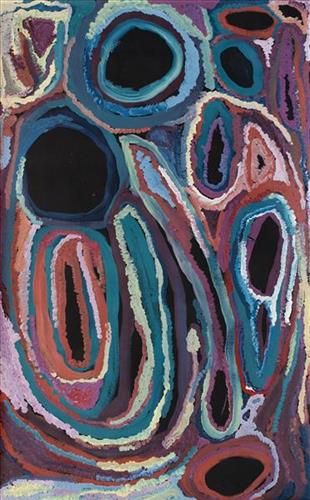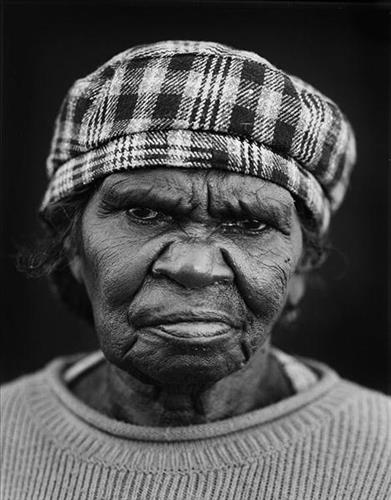111581846617
Pitu (Separation Well)
“Ngurra me, my ngurra (this is my Country, my home). Mummy mili Pitu and Kulilu (My mother’s home Country is around the permanent springs of Pitu and Kulilu). I been born [at] Pitu. Two mummy, one daddy born there too there. Two yinta (permanent springs) [can be found in the area], one Pitu name. Kirti-kirti (hill kangaroos) everywhere there, good hunting Country. Jila (snake) resting there, dream time. Minyipuru (Jakulyukulyu, Seven Sisters), they travelled through Pitu.”
– Jakayu Biljabu
“Jakayu paints the main yinta that sustained her family during the pujiman (traditional, desert dwelling) days. Pitu and Kulilu is part of Jakayu’s story, part of her home. It’s who she is. This painting shows Pitungakal ngurra, nyaku Kulilu, Jakayu’s ngurra (Jakayu paints looking towards her home Country, Pitu. From here she will see Kulilu, also her home Country). Jakayu walked around here with her mother and father and her two jarntu (dingoes) as a young girl. [This painting] shows the yinta, wattle shrubs and tuwa (sand hills) all around that place. Kalyukaja (plenty of water) all across that Country. Yinta, Kulilu, kalyukaja (that waterhole, Kulilu, is full of water). Pitu is serpent Country. That jila came across from Wirnpa [soak], travelling south through Pitu, making a big mob of kapi (water). Jila is an important ancestral spirit that mapped out that Country.”
– Jakayu Biljabu, as translated by Glady’s Bidu (Jakayu’s niece and daughter in law)
Pitu (Separation Well) is an important cultural site and large soak located yulparirra (south) of Wuranu (Canning Stock Route Well 29) and Kulilu rockhole and soak. Pitu is Jakayu’s and her mother’s birthplace, and forms an integral part of her ngurra (home Country, camp). Jakayu grew up in this area; she knew the region intimately and travelled around here extensively with her family in her youth. During this time Jakayu’s family would regularly meet around here with fellow Martumili Artists Bugai Whyoulter and Ngamaru Bidu and their families.
As a site where fresh water was available all year, Pitu was an important camp and a meeting place for Kartujarra and Manyjilyjarra people during the pujiman era. At this time, knowledge of water sources was critical for survival, and today Martu Country is still defined in terms of the location and type of water. Each of the hundreds of claypans, rockholes, waterholes, soaks and springs found in the Martu desert homelands is known by name, location, quality and seasonal availability through real life experience and the recounting of Jukurrpa (Dreaming) narratives.
In her account of the area, Jakayu refers to the Jukurrpa events that occurred in and around Pitu. Most significant is the journey of an ancestral rainmaking jila from the Percival Lakes region to Pitu, where it now resides. The Western Desert term jila is used interchangeably to describe springs considered to be ‘living’ waters and snakes, both of which play a central role in Martu culture and Jukurrpa. Of the many permanent springs in Martu Country, very few are ‘living waters’; waters inhabited by jila. Before they became snakes, these beings were men who made rain, formed the land and introduced cultural practices like ceremonies and ritual songs. Some of the men travelled the desert together, visiting one another, but they all ended their journeys at their chosen spring alone, transformed into a snake. Like Pitu, these important springs are named after their jila inhabitant. The Minyipuru also visited this site during their epic travels eastward across Australia. Minyipuru is a central Jukurrpa narrative for Martu, Ngaanyatjarra, Pitjantjatjara and Yankunytjatjara people that is associated with the seasonal Pleiades star constellation.




